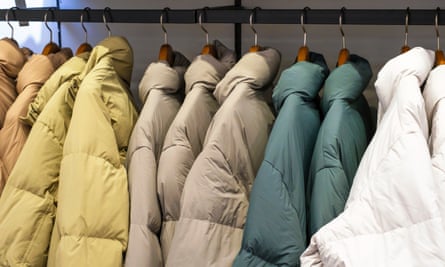There is a lot of plastic hidden in our clothes. Sometimes it’s in plain sight, like a pair of pleather trousers that squeak with every step. Sometimes it’s disguised, like the elastic inside the waistband of your otherwise organic cotton shorts. Often it is invisible, like the microplastics shed by synthetic materials; while you may never see them, they have been found at the bottom of the ocean and in human blood, placenta and baby poo.
Despite our awareness of the perils of plastic, fashion’s dependence on it persists. A recent report by the sustainability not-for-profit Fibershed says between 1980 and 2014, production of polyester increased by nearly 900%.
Two common plastics, polyester and nylon, account for 69% of all the materials used in clothing globally and that number is expected to increase to 75% by 2030, according to Georgia Rae-Taylor, the sustainability strategy director for environmental consultancy Eco-age.
So why do we continue to use plastics? Synthetic materials are cheap and making them isn’t dependent on seasons or farms affected by rainfall or heatwaves, as is the case with cotton and wool. Without them, fast fashion and mass-produced luxury – as well as the incredible waste they generate – would almost certainly not exist.
“Material sourcing of our clothing matters,” says Heather Podoll who works at Fibershed. “Our plastic-based textile economy has led to unsustainable overproduction of clothing that is unhealthy for our communities and our ecosystems.”
So, besides the glaringly obvious, what other plastic is hidden in our wardrobes, and how can we do our best to avoid it or minimize its harm?
Textiles
Of course polyester trousers are made of plastic, but sometimes labels are less straightforward. When you check a garment’s fabric composition, it’s not uncommon to be confronted by a list of scientific words. For example: polyethylene terephthalate (Pet), polyamide, polyurethane, polyvinyl chloride (PVC) or polypropylene. Which are all types of plastic.
Some of the more common ones like nylon, acrylic and elastane are plastic, too. To make things even more confusing, sometimes brand names, such as Lycra or Spandex which are types of elastane, are used in their place. Or Econyl and Repreve, which are made from plastic waste and are nylon and polyester respectively. Recycled synthetics are increasingly common and while making fabrics from plastic waste reduces the fashion industry’s reliance on crude oil, it is not without its issues.
Tip Always check the garment care label and be sure to search any names you’re unfamiliar with online. Or turn to brands that prioritize natural materials.
Threads

Although this is rarely accounted for on garment labels, the thread used to sew your otherwise eco-friendly white linen shirt together is almost always synthetic. This is because plastic threads can be made from one long continuous filament which makes them stronger, and less likely to break compared with cotton threads.
Tip This is a tricky one to avoid because brands rarely disclose what their threads are made from. Brands that promote their collections as compostable, such as Stripe and Stare or The Very Good Bra, should have done due diligence. But note that compostability is a higher and different standard to biodegradable and an industry wide, third-party certification for this is yet to be created.
Buttons and zippers

There was a time when buttons were delicate baubles carved from shells and wood or fashioned from metal, ceramics and glass, but sadly this is no longer the case; now they are usually made from plastic. Similarly, most hook and eyes, like the ones used to close bras or secure the top of a fly, are made from plastic, too. And while the teeth of some zippers will be made from metal, the fabric they are set into is almost always synthetic.
Tip Look for natural buttons made from corozo nut or wood, and for hook and eyes made from metal. High quality zippers will also be made from metal, but unfortunately it’s very rare to find a zip that’s not set in plastic fabric, so the best thing to do is avoid garments with zips where possible. Brands can work around the limitations of the available materials by designing pieces that fasten in different ways. Or thinking differently, for example the zero-carbon designer Angel Chang uses an ancient technique to create buttons made from cotton knots.

Padding, reinforcement and warmth
Another place plastics hide in our clothes is the materials that provide stiffness and reinforcements. In bras, padding provides structure and support. Stiffness is also necessary in collars, cuffs and waistbands. This is usually achieved with fusing, which is generally a piece of polyester that’s bound to the garment by applying glue and heat. The insulation in puffer jackets and vests used to be made from duck or goose feathers but is now mostly polyester synthetic fill.
Tip The more simply a garment is constructed, the easier it is to avoid plastic. If you can, look for bras without padding or that use cotton or cellulose-based wadding instead. When it comes to puffer jackets, there are innovations in this space exploring plant-based alternatives such as flowers, bamboo and wood but at the moment they still rely on some type of bioplastic.
Tags and care labels
According to circularity consultant and designer Courtney Holm, one of the biggest challenges she faced when trying to remove synthetic materials from her clothes was the labels. Natural material labels were so hard to come by and print on, she says, “so we had to compromise with a recycled Pet option for our labels in the early days”, before eventually convincing suppliers to switch to a bio-based alternative.
Tip Holm’s experience is evidence of what can be achieved when designers ask more from their suppliers. Asking questions of your favourite brands about what their tags and care labels are made from could be a way to bring about change. You could even point them in the direction of this opensource guide by New Zealand brand Kowtow which shares the knowledge they gained when making their brand plastic-free.

Lining
Lining is another place plastics get hidden in our clothes. While polyester and nylon are smooth enough to provide one of the intended benefits of lining – making it easier to put your arm through a sleeve or step into a pair of trousers – because they are plastic, they ultimately do garments a great disservice. Unlike silk or viscose rayon that breathe, synthetic materials trap heat and hold on to odours.
Tip Look for garments lined with silk, cotton or a human-made cellulose material such as viscose rayon, cupro, modal or lyocell.
Pockets
The material used to make pockets needs to be durable (so it doesn’t split under the weight of your phone) and thin (so they don’t upset the line of the garment). This means they are often made from polyester or nylon.
Tip Look for garments with pocket bags made from cotton, hemp or a human-made cellulose material like viscose rayon, cupro, modal or lyocell.

Sequins, beads and other shiny things
Most shiny adornments on garments are made of plastic. Once upon a time sewing metals, glass beads and jewels on to garments signified wealth but this hasn’t been the case for a long time. Plastic beads and jewellery made from Bakelite, a plant-based plastic, became popular around 1910. Similarly, sequins have been made from PVC, polyester and nylon since the 1950s.
Tip There are sequins made from recycled Pet on the market but these can still break into microplastics. And there are bio-based sequin alternatives being piloted from plant matter and algae, but these aren’t widely available yet. The best thing to do with any sequined or beaded outfits in your wardrobe is to take them to a local dressmaker or garment restorer for a touch up, to ensure nothing is at risk of falling off.

Vegan leather and faux fur
The vegan leather currently widely available is made from a combination of polyester, polyurethane and occasionally some kind of plant matter. Unfortunately, almost every plant-based leather on the market relies on some synthetic components for durability or flexibility. Similarly, most of the faux fur available is just an amalgamation of acrylic polymers, polyester or nylon.
Tip The good news is that real leather is an incredibly durable and repairable material, and when cared for properly should last for years. So, there is an abundance of vintage leather pieces that are better for the environment than plastic leathers. If you avoid leather for moral reasons, the best plastic-free alternatives are Mirum, a truly plant-based, plastic-free leather, and TomTex (although this isn’t strictly vegan because as well as mushrooms, it’s made from waste seafood shells). There are companies working on plant-based faux furs but most of these still use some plastic and as they are incredibly likely to shed microplastics, it’s best to avoid them.

